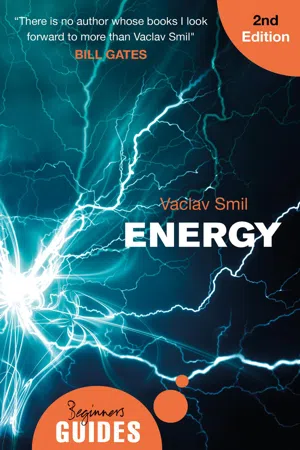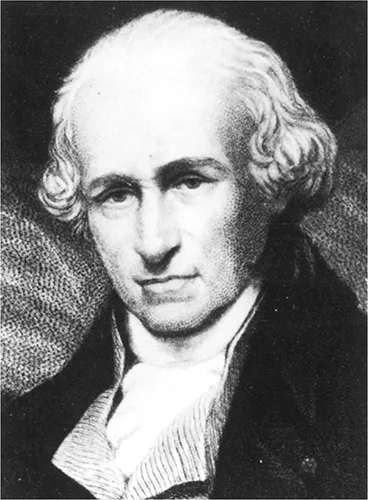
- 240 pages
- English
- ePUB (mobile friendly)
- Available on iOS & Android
eBook - ePub
About this book
With one famous equation, E=mc2, Einstein proved all matter can be described as energy. It is everywhere and it is everything.
In this newly updated and engaging introduction, renowned scientist Vaclav Smil explores energy in all its facets – from the inner workings of the human body to what we eat, the car we drive and the race for more efficient and eco-friendly fuels.
Energy: A Beginner's Guide highlights the importance of energy in both past and present societies, by shedding light on the science behind global warming and efforts to prevent it, and by revealing how our daily decisions affect energy consumption. Whether you're looking for dinner table conversation or to further your own understanding, this book will amaze and inform, uncovering the truths and exposing the myths behind one of the most important concepts in our universe.
In this newly updated and engaging introduction, renowned scientist Vaclav Smil explores energy in all its facets – from the inner workings of the human body to what we eat, the car we drive and the race for more efficient and eco-friendly fuels.
Energy: A Beginner's Guide highlights the importance of energy in both past and present societies, by shedding light on the science behind global warming and efforts to prevent it, and by revealing how our daily decisions affect energy consumption. Whether you're looking for dinner table conversation or to further your own understanding, this book will amaze and inform, uncovering the truths and exposing the myths behind one of the most important concepts in our universe.
Frequently asked questions
Yes, you can cancel anytime from the Subscription tab in your account settings on the Perlego website. Your subscription will stay active until the end of your current billing period. Learn how to cancel your subscription.
No, books cannot be downloaded as external files, such as PDFs, for use outside of Perlego. However, you can download books within the Perlego app for offline reading on mobile or tablet. Learn more here.
Perlego offers two plans: Essential and Complete
- Essential is ideal for learners and professionals who enjoy exploring a wide range of subjects. Access the Essential Library with 800,000+ trusted titles and best-sellers across business, personal growth, and the humanities. Includes unlimited reading time and Standard Read Aloud voice.
- Complete: Perfect for advanced learners and researchers needing full, unrestricted access. Unlock 1.4M+ books across hundreds of subjects, including academic and specialized titles. The Complete Plan also includes advanced features like Premium Read Aloud and Research Assistant.
We are an online textbook subscription service, where you can get access to an entire online library for less than the price of a single book per month. With over 1 million books across 1000+ topics, we’ve got you covered! Learn more here.
Look out for the read-aloud symbol on your next book to see if you can listen to it. The read-aloud tool reads text aloud for you, highlighting the text as it is being read. You can pause it, speed it up and slow it down. Learn more here.
Yes! You can use the Perlego app on both iOS or Android devices to read anytime, anywhere — even offline. Perfect for commutes or when you’re on the go.
Please note we cannot support devices running on iOS 13 and Android 7 or earlier. Learn more about using the app.
Please note we cannot support devices running on iOS 13 and Android 7 or earlier. Learn more about using the app.
Yes, you can access Energy by Vaclav Smil in PDF and/or ePUB format, as well as other popular books in Physical Sciences & Energy Industry. We have over one million books available in our catalogue for you to explore.
Information
1
Energy in our minds: concepts and measures
The word energy is, as are so many abstract terms (from hypothesis to sophrosyne), a Greek compound. Aristotle (384–322 B.C.E.) created the term in his Metaphysics, by joining en (in) and ἐργον (work) to form ἐνέργεια (energeia, “actuality, identified with movement”) that he connected with entelechia, “complete reality.” According to Aristotle, every object’s existence is maintained by energeia related to the object’s function. The verb energein thus came to signify motion, action, work, and change. No noteworthy intellectual breakthroughs refined these definitions for nearly two subsequent millennia, as even many founders of modern science had very faulty concepts of energy. Eventually, the term became practically indistinguishable from power and force. In 1748, David Hume (1711–1776) complained, in An Enquiry Concerning Human Understanding, that “There are no ideas, which occur in metaphysics, more obscure and uncertain, than those of power, force, energy or necessary connexion, of which it is every moment necessary for us to treat in all our disquisitions.”
In 1807, in a lecture at the Royal Institution, Thomas Young (1773–1829) defined energy as the product of the mass of a body and the square of its velocity, thus offering an inaccurate formula (the mass should be halved) and restricting the term only to kinetic (mechanical) energy. Three decades later the seventh edition of the Encyclopedia Britannica (completed in 1842) offered only a very brief and unscientific entry, describing energy as “the power, virtue, or efficacy of a thing. It is also used figuratively, to denote emphasis in speech.” Little has changed in popular discourse since that, or indeed since Hume’s, time, except the frequency of the term’s misuse. At the beginning of the twenty-first century energy, its derivative verb (energize) and its adjective (energetic), are used ubiquitously and loosely as qualifiers for any number of animated, zestful, vigorous actions and experiences, and energy is still routinely confused with power and force. Examples abound: a powerful new chairman brings fresh energy to an old company; a crowd is energized by a forceful speaker; pop-culture is America’s soft power.
Devotees of physical fitness go one step further and claim (against all logic and scientific evidence) they are energized after a particularly demanding bout of protracted exercise. What they really want to say is that they feel better afterwards, and we have a perfectly understandable explanation for that: prolonged exercise promotes the release of endorphins (neurotransmitters that reduce the perception of pain and induce euphoria) in the brain and hence may produce a feeling of enhanced well-being. A long run may leave you tired, even exhausted, elated, even euphoric – but never energized, that is with a higher level of stored energy than before you began.
Science of energy: origins and abstracts
Sloppy use of ingrained terms is here to stay, but in informed writing there has been no excuse for ill-defined terms for more than a hundred years. Theoretical energy studies reached a satisfactory (though not perfect) coherence and clarity before the end of the nineteenth century when, after generations of hesitant progress, the great outburst of Western intellectual and inventive activity laid down the firm foundations of modern science and soon afterwards developed many of its more sophisticated concepts. The ground work for these advances began in the seventeenth century, and advanced considerably during the course of the eighteenth, when it was aided by the adoption both of Isaac Newton’s (1642–1727) comprehensive view of physics and by engineering experiments, particularly those associated with James Watt’s (1736–1819) improvements of steam engines (Figure 1; see also Figure 19).
During the early part of the nineteenth century a key contribution to the multifaceted origins of modern understanding of energy were the theoretical deductions of a young French engineer, Sadi Carnot (1796–1832), who set down the universal principles applicable to producing kinetic energy from heat and defined the maximum efficiency of an ideal (reversible) heat engine. Shortly afterwards, Justus von Liebig (1803–1873), one of the founders of modern chemistry and science-based agriculture, offered a basically correct interpretation of human and animal metabolism, by ascribing the generation of carbon dioxide and water to the oxidation of foods or feeds.

Figure 1 James Watt
The formulation of one of the most fundamental laws of modern physics originates in a voyage to Java made in 1840 by a young German physician, Julius Robert Mayer (1814–1878), as ship’s doctor. The blood of patients he bled there (the practice of bleeding as a cure for many ailments persisted well into the nineteenth century) appeared much brighter than the blood of patients in Germany.
Mayer had an explanation ready: blood in the tropics does not have to be as oxidized as blood in temperate regions, because less energy is needed for body metabolism in warm places. But this answer led him to another key question. If less heat is lost in the tropics due to radiation how about the heat lost as a result of physical work (that is, expenditure of mechanical energy) which clearly warms its surroundings, whether done in Europe or tropical Asia? Unless we put forward some mysterious origin, that heat, too, must come from the oxidation of blood – and hence heat and work must be equivalent and convertible at a fixed rate. And so began the formulation of the law of the conservation of energy. In 1842 Mayer published the first quantitative estimate of the equivalence, and three years later extended the idea of energy conservation to all natural phenomena, including electricity, light, and magnetism and gave details of his calculation based on an experiment with gas flow between two insulated cylinders.
The correct value for the equivalence of heat and mechanical energy was found by the English physicist (see Figure 2) James Prescott Joule (1818–1889), after he conducted a large number of careful experiments. Joule used very sensitive thermometers to measure the temperature of water being churned by an assembly of revolving vanes driven by descending weights: this arrangement made it possible to measure fairly accurately the mechanical energy invested in the churning process. In 1847 Joule’s painstaking experiments yielded a result that turned out to be within less than one percent of the actual value. The law of conservation of energy – that energy can be neither created nor destroyed – is now commonly known as the first law of thermodynamics.
In 1850 the German theoretical physicist Rudolf Clausius (1822–1888) published his first paper on the mechanical theory of heat, in which he proved that the maximum performance obtainable from an engine using the Carnot cycle depends solely on the temperatures of the heat reservoirs, not on the nature of the working substance, and that there can never be a positive heat flow from a colder to a hotter body. Clausius continued to refine this fundamental idea and in his 1865 paper he coined the term entropy – from the Greek τρόπος (way) – to measure the degree of disorder in a closed system. Clausius also crisply formulated the second law of thermodynamics: entropy of the universe tends to maximum. In practical terms this means that in a closed system (one without any external supply of energy) the availability of useful energy can only decline. A lump of coal is a high-quality, highly ordered (low entropy) form of energy; its combustion will produce heat, a dispersed, low-quality, disordered (high entropy) form of energy. The sequence is irreversible: diffused heat (and emitted combustion gases) cannot be ever reconstituted as a lump of coal. Heat thus occupies a unique position in the hierarchy of energies: all other forms of energy can be ...
Table of contents
- Cover
- Title Page
- Dedication
- Contents
- List of Figures
- 1: Energy in our minds: concepts and measures
- 2: Energy in the biosphere: how nature works
- 3: Energy in human history: muscles, tools, and machines
- 4: Energy in the modern world: fossil-fueled civilization
- 5: Energy in everyday life: from eating to emailing
- 6: Energy in the future: trends and unknowns
- Further readings and data sources
- Index
- Copyright